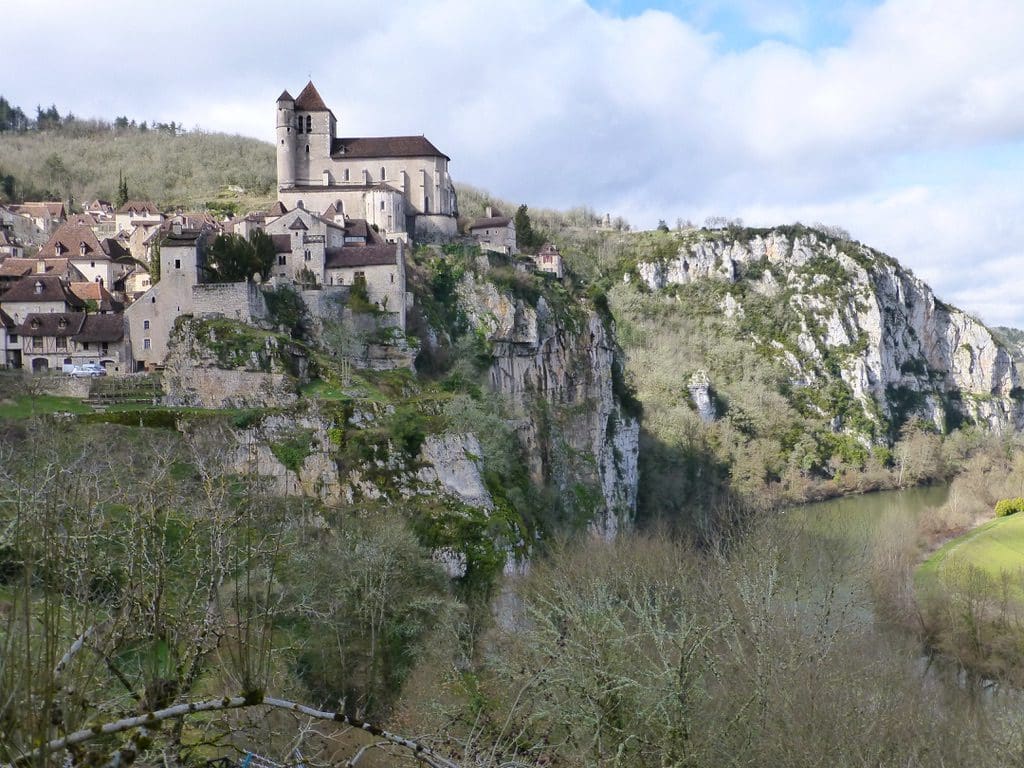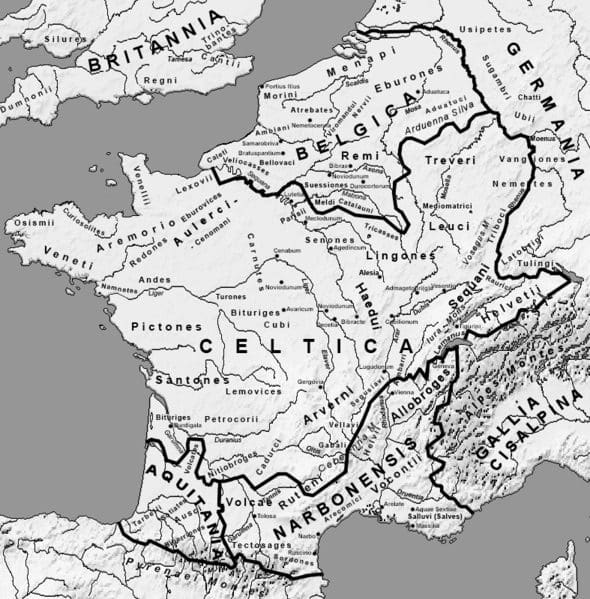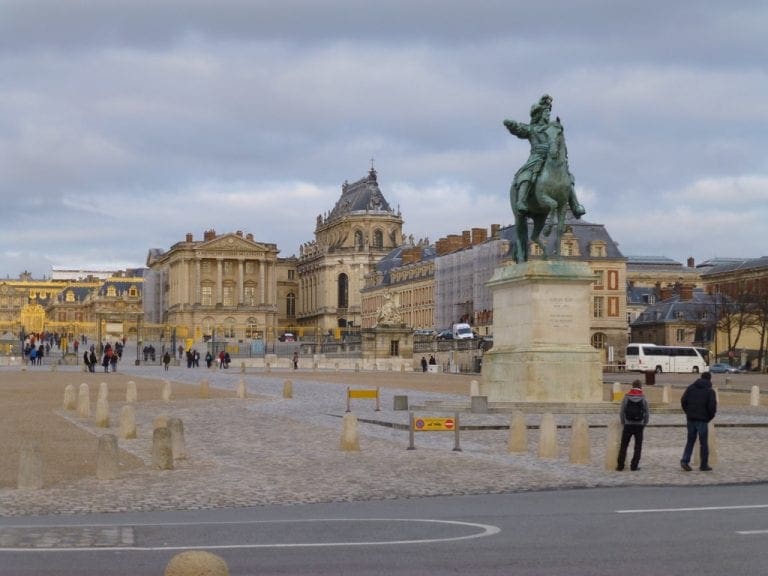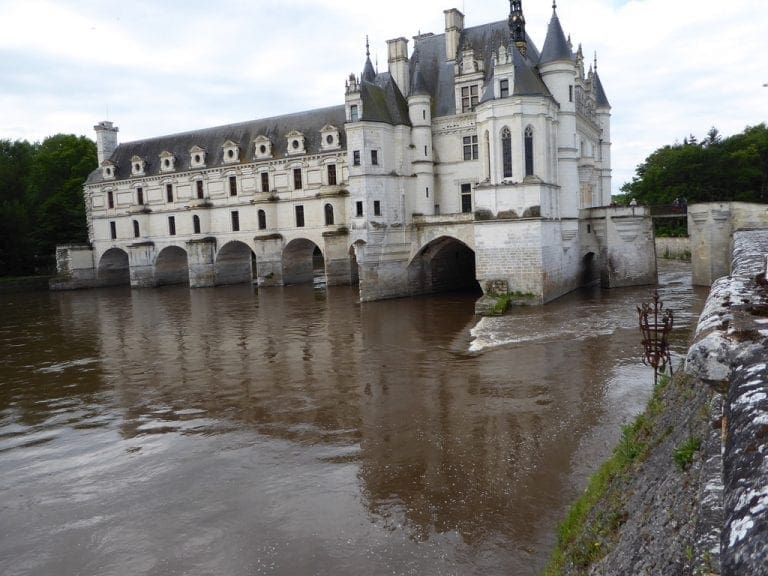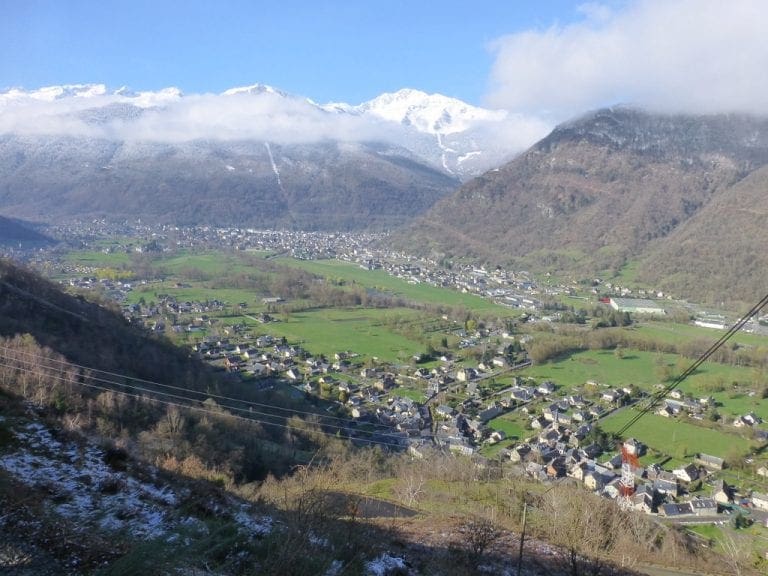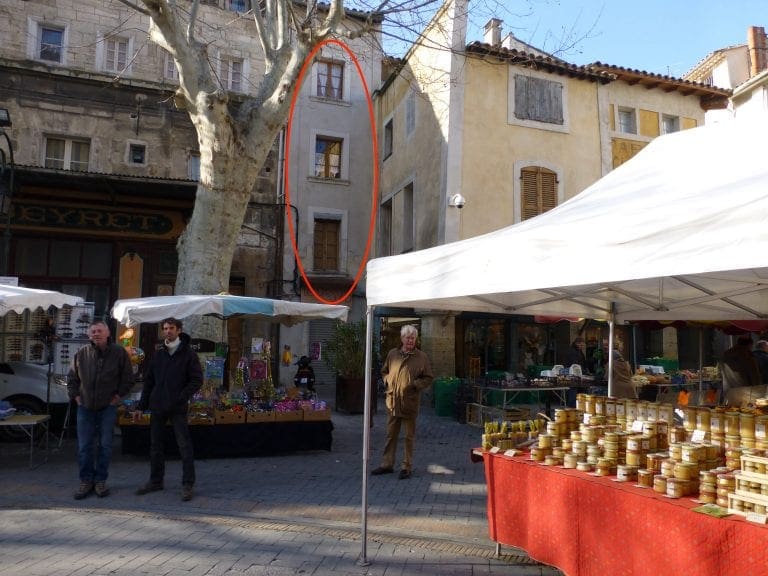France 2013 – week 6 – Cajarc
9 Mar 2013. Saturday. Day 36. Warm, sunny day after an early light shower 20C. The big market is on Saturday in Sarlat and our landlord has let us stay until noon so we can have a good look around the market. The car is parked about 350m away. So I’ve lugged the two big bags down the 75 steps and trundled them over the cobble stones, through the market and up the hill. One at a time. As I write this I’ve been down and up those 75 steps four times. Very good for the cardio and knees. The newer roofs here are of carefully cut slate. In winter, on their northern sides they grow a crop of moss. The pigeons clean the moss off letting it fall to the street. Why they do this is not clear. Under contract from the mayor or the building owners? They begin cooing at first light and keep up a low level coo all through the day – and, Helen reports, much of the night.
The market today had the same stall holders as were here on Wednesday plus many more. The market is well frequented by locals who arrive with their wheelie bags or carry bags and greet each other and the stall holders – and say ‘see you next week’ when leaving. For the stall holders, it is very much a social occasion. Many are much more interested in talking to each other than in selling to customers. I saw the first bottles of wine being opened by 9am. Picture this – small group standing around a tall table covered with chunks of bread and pieces of cheese, plastic cups for the wine – all talking at once, arms and hands used for emphasis – keeping a bit of an eye out for any customers who might approach their stall. The lady who sold us cheese on Wednesday was so busy talking that she had not had time to set up her stall properly. Same today.
At noon, Paula, Barry and Reese arrived to say goodbye. (It is always strange to me that we meet these very nice people for 30 mins at the start of our visit and 30 mins at the end. It would be good to be able to spend longer with them.) We had our last trip down the 75 stairs and through the market – bye bye stairs.
Drove to Cajarc which is just over an hour away. It might as well be in another country. We’ve moved Departments again. Now we are in Lot (Department number 46). The road took us up over a very barren harsh limestone plateau on a beautiful straight wide road, then, down and across the narrowest bridge I’m been over in a car (and with the worst approach). Cajarc is almost the smallest village we will be in.
The ‘Stone House’ here is the second largest of the cottages – two bedrooms upstairs, kitchen and dining downstairs. Very nice. The first thing we were warned to do was to buy paraffin heating oil – as the house is usually let only in summer and has just a couple of oil heaters. (This turned out to be a bit of an adventure. We were told to ask for ‘paraffin’. ‘Paraffin – as a liquid’ was the very puzzled reply. With much pointing, we found the right product in big drums by the door. While we were searching the store, we saw several people fill up 2-4 litre containers from a pump near a wall. Wine. Bulk wine – vin de table sold by the litre.) We can park about 50m from the House. This is a delightful, well appointed house – it even has a picnic hamper and blanket. (Sarlat, Cajarc and the next house at Montignac do not have wifi. Finding wifi in these small villages will be a challenge.)
10 Mar 2013. Sunday. Day 37 (50 days to go). Cajarc is a very old village about 100m in diameter and surrounded by a narrow ring road (that used to be a moat). The only straight-ish street is the remains of the old Roman road. The oldest houses are 12th century with several from 16th century. Almost no drivable roads in the village itself. Our Stone House is on one of the wider, jagged alley-ways (about 2 m wide). On the first morning in any new village, the first thing to do is find the baker. We walked clockwise around the ring road (perhaps ‘ring street’ would be a closer descriptor) looking for the baker – behold 1/3 of the way around we found a baker with a line up. Must be good – and the only one open. Very good bread and the usual friendly service.

After breakfast, we went for a walk down to and along the River Lot. A very nice river. Like the Dordogne, this was used by vikings raiding up into France in the 900s. Now it has a string of weirs and at Cajarc produces electricity.
The ‘Stone House’ is recent. It was built about 200 years ago – say c 1810. It had fallen into ruin and was a shell with an old lady and her goats. It was purchased and restored by a Belgian in 1999. In the village, a house ‘Maison de Herbrardie’ (with gothic windows) was built with the remains of a 13th century castle. At the edge of the village is a ruined 12th century chapel that was a leper asylum. This Cajarc cottage is one of the three ‘cottages’ that had done extremely well with its advertising on homeaway. I had to stay here. It was so appealing. And it is appealing.
We could not find a restaurant open for Sunday lunch – what a step out of the tourist conscious Dordogne does that signify – so we had a picnic by the river. This is a ‘working’ village, the first we have stayed in on this trip, struggling to make a living from the land – and here the land is tough limestone ridges and a bit of thin arable land in the valleys. It might become what the Dordogne has become with its influx of tourists, but not yet. It still awaits that injection of funds.
11 Mar 2013. Monday. Day 38. Sunny and 18C. A drive. First, to St Cirq Lapopie perched on its hillside looking over the Lot River. Beautiful and we arrived early to beat the hoards of tourists (by a couple of months). The most remarkable thing about St Cirq Lapopie is that it is the village that won the marketing battle. Probably because it had money thrown at it first. There are many other villages along the Lot and the Cele that would qualify for ‘most beautiful in France’.
Each bend of the River reveals yet another fairyland village perched on its hillside – and that was the main story of the day. Along the Rivers Lot and Cele we found dozens of ideal summer camping spots next to fairytale villages.

After climbing up and down the extremely steep streets and lanes of St Cirq Lapopie, we drove off looking for lunch. The objective was to find a lunch spot that the locals used. The trick is that the place will look empty before noon and after 1pm but parked out in between. So, we had an hour to find one. We had the picnic in the back for just in case. But, not needed. Voila!! A lunch spot with trucks, vans and cars at Saint Gery filled with blokes in muddy boots who said ‘see you tomorrow’ when they left. A fixed menu of soup, steak and kidney stew with pasta (not the best thing I’ve ever tasted), 500ml wine, cheese or dessert, and coffee. Good wholesome tucker. €26 for the two of us. Not a meal to remember for the food so much as for the chase and muddy boots.

From there, we drove up along the River Cele and the real adventure of little villages began. Especially, the little town of Cabrerets which clings to its rock face in much the same way that La Roque Saint-Christophe from the Dordogne last week. But, Cabrerets is still lived in! Each of the bends in the river Cele had its own cluster of houses and many had their own mill. The one at Cabrerets was making electricity and the one at Sauliac sur Cele was grinding grain. Tough country though. The Lot and Cele cut down through a very tough limestone plateau. Very little arable land. But an excellent scenic and recommended drive for tourists.
12 Mar 2013. Tuesday. Day 39. Rain and snow 3C. A long drive today. We set out for Rocamadour which is a marvelous sight on its cliff and major pilgrimage site – but did not get out of the car. We decided to drive through and around the hill-top towns and villages of the upper Dordogne River – St Cere, Autoire, Bretenoux and Castelnau (yes another one of them). Our real objective was to have lunch overlooking the Rive Cere (not to be confused with the River Cele of yesterday). As it turned out, it snowed on us right across that upland part of the plateau – quite heavy at times but not enough to settle on the very wet ground. We did not stop at the high point – could not see a thing – as my favourite Japanese poet says ‘in a way it was fun not to see Mt Fuji in the mist and rain’ (Substitute ‘Gorges of Cere’ for ‘Mt Fuji’ and you have it.) Back down the winding road to Cajarc. The snow stopped when we dropped down a bit. (It turned out that that snow had closed airports, stopped trains and caused a few deaths. We were lucky that we just got the edge of it and dropped down from the high plateau when we did. Big news the next day. I did not want to be a news item, so we had our picnic in the car when we had dropped below the snow fall.)
Along the way, all was not lost. About every 1/2 km along the way, the Cere (or Cele when we crossed back to it), was dammed with a metre high weir. Many are still in use – electricity, grain, sawmill. This is difficult country to farm – but the rivers and their productive mills would have given quite a good economy. Much diminished now. There is no shortage of stone houses in France that are waiting to be renovated. Every village has 20 to 200. You would just need to find your dream location and spend your time and money fixing it up. What a project!
13 Mar 2013. Wednesday. Day 40. Snowing all morning and cold 5C. A very quick walk in blowing snow to get the bread. The snow was very fine and constant but did not settle. We ventured out to the tiny local market to buy lunch (from the local butcher – including wine from his shelves – where else should you buy wine to go with the meal. You buy the meat and say ‘what wine would you suggest to go this.’ It was good actually.) As you might expect, the market was struggling on its exposed corner in the blowing snow – very bleak.
We ventured another trip to the biggest of the local cafe/restaurants to test their wifi. Not good – not free despite the sign. Along the way back from the bread this morning, I finally found the 12th century house that I’ve been looking for and walking past at least twice a day for 4 days. Hiding in very plain sight. Surprisingly, it had not dodged back out of sight when I went to look for it again. Strange things 12th century houses. We huddled down and read our books in front of the heaters for the afternoon. Luckily, Helen has found a little electric fan heater. That has saved us. The one oil heater that I could get to work drinks oil at an alarming rate. With the electric heater doing a chunk of the work, oil drinking is now controlled. One of the first things Helen did when we arrived on Saturday was to strip all the blankets off the beds and put them on ours. The lunch from the local butcher was a very good ragout to which we added a ailgot (mashed spuds with cheese – from the market) and the butcher’s wine. Later followed but walnut cake and cheese (also from the market).
14 Mar 2013. Thursday. Day 41. A cold 3C with a gentle wind. Snow on the ground in sheltered parts, on the roofs and cars. The plan for the day was to walk along the old haulage path below St Cirq Poppie. This path was cut into the cliff and used to haul barges up the river. Once again our plans were foiled by a ‘Route Barre’ sign. A team was barring down loose rocks from the cliff and letting them crash onto the haulage path and into the river. Certainly not safe for us. Plan B was developed after a little discussion.
We went west to Cahors to see the fortified bridge. That did not take long, so Plan C emerged. Cahors is supposed to be a major wine growing area. On our way to Cahors, we had not seen a single grape vine. So, we went south into an area that was marked on their map as a major growing area. Again, not a vine to be seen. The other part of this plan was to drive through the country to the south of the Lot. More tiny villages next to very small pastures and ploughed fields. It is very hard to see how this area makes a living. (One of my hidden agendas for doing that was to avoid driving the rocky road along the north side of the Lot. A rock wall forms the side of the very narrow road without any verge. Many bits of sticking out rock and overhangs. Very bad for the nerves of the driver and passenger – especially with cars on the other side zooming along at 90 but taking a bit of our lane because they are avoiding the stone wall on their side.) Back to Cajarc for lunch and a further explore of the wifi. Found a free wifi in the pub/tab and managed to get ‘week 4’ off and a fair way through week 5 before the 5pm crowd arrived.
Cajarc has been a disappointment. I know, that the weather has been bad, but the Lot just does not have the points of interest of the Dordogne. Certainly, after the first 5 weeks of whirling around, this is a bit slow. Rural, small village France. However, in a way, that is exactly what we want. Cajarc is a village of 1,100 people. Everyone talks to everyone else and knows each other’s business.
15 Mar 2013. Friday. Day 42. A sunny day 8C with a very light breeze. A good frost this morning. It is sooo good to see the sun. We went for a very short drive to the nearby hill-top village of Calvignac. To me Calvignac and St Cirq Poppie are very similar. Poppie won the marketing battle and has had much money thrown at it. Calvignac has the same kind of commanding position, old chateau, castle – but is crumbling with restoration money arriving much later. Most of the Lot valley would be deserted stone ruins except for the re-building/restoration programs, the subsequent tourists and purchases of summer houses – a cycle that now feeds itself.
After Calvignac, we hurried back to Cajarc for – lunch. The main plan for the day was lunch. Recall, that lunch is the main meal of the French day. It begins as close as 1 second after noon as possible. I think that the warning is true – ‘don’t stand between a Frenchman and his lunch’ – especially at 11:55. Cajarc (village of 1,100) has 7 restaurants. Three are extremely good (2 have Michelin recommendations) and the others just good. In winter, the better ones are closed. We chose the “L’allee des Vignes” which has been closed for its winter break and re-opened on Wednesday. Excellent. We both had the meal ‘formula’ – 3 courses and coffee €17.50 each – with a bottle of wine and pre-drinks the total was €59.50. How do they do that? We talked about this and the economy of the Lot for most of lunch. The demand for such good food has clearly raised the standard and kept meal prices low. Let us say that Cajarc is the same size as Hughenden (north Queensland). Both in similar agricultural areas. Both struggling. Hughenden does not have 7 good restaurants and 3 bakers.
After lunch and a sit in the sun by the river watching a bloke pull very tiny fish out of the water and working out where all the planes were going that we could see overhead, we spent the afternoon in the local pub with a wifi. I got ‘week 5’ off. By 5pm, the pub was quite crowded, so we moved out. For want of something to drink I had a Ricard. Ok-ish. €1.70 for a glass of spirits. Alcohol is very cheap.
As it turned out, I find it hard to recommend Cajarc in winter. It might be very nice in summer. I’ve spun it a best as I could. If we were more mobile, I would not have stayed more than 3 days.
